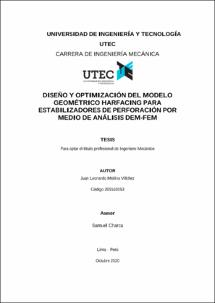| dc.contributor.advisor | Charca Mamani, Samuel | |
| dc.contributor.author | Molina Vilchez, Juan Leonardo | |
| dc.date.accessioned | 2020-12-11T22:00:56Z | |
| dc.date.available | 2020-12-11T22:00:56Z | |
| dc.date.issued | 2020 | |
| dc.identifier.citation | Molina Vilchez, J. L. (2020). Diseño y optimización del modelo geométrico harfacing para estabilizadores de perforación por medio de análisis DEM-FEM [Tesis de Título Profesional, Universidad de Ingeniería y Tecnología]. Repositorio Institucional UTEC. https://hdl.handle.net/20.500.12815/170 | es_PE |
| dc.identifier.uri | https://hdl.handle.net/20.500.12815/170 | |
| dc.description.abstract | El presente trabajo de investigación se centró en el diseño y selección de una geometría óptima para la soldadura de blindaje sobre los estabilizadores utilizados en perforación en la industria minera y de construcción durante la perforación de túneles. Para ello se realizó un análisis por elementos discretos (Rocky-DEM) acoplado al análisis de elementos finitos considerando condiciones fijas como velocidad de rotación, fuerza de empuje, torque de perforación y características físico mecánicas de las rocas a perforar por el método Raise borer. Para ello, se usó como material a perforar la roca intrusiva Diorita por su mayor presencia en la zona seleccionada, cuyas propiedades mecánicas se determinaron usando ensayo de compresión triaxial y ensayo de compresión confinada. Los resultados determinados son muy cercanos a los observados en la literatura (módulo de Young: 13.57 GPa, Coeficiente de Poisson: 0.305 y una resistencia a la comprensibilidad 60.98 MPa). Por otro lado, la simulación por elementos discretos se realizó por medio de Rocky-DEM y se consideró como variable principal la orientación y ángulos de inclinación del cordón de soldadura. El método por elementos discretos brindó las coordenadas locales, orientación y la magnitud de las fuerzas generadas al impacto entre la roca y la superficie de la soldadura de blindaje. Posteriormente, por medio del método de elementos finitos se analizó los esfuerzos resultantes sobre el estabilizador. Con el análisis realizado se logró seleccionar la geometría con forma cascada por su distribución de esfuerzo homogéneo sobre los cordones de soldadura, lo que refleja un desgaste uniforme sobre la superficie y la anulación de zonas críticas en dónde ocurriría desgaste prematuro. | es_PE |
| dc.description.abstract | This research was focused on the design and selection of the optimal geometry for armor welding on stabilizers used in tunnel drilling in the mining and construction industry. For this, a discrete element analysis (Rocky-DEM) was carried out coupled with the analysis of finite elements considering fixed conditions such as rotation speed, thrust force, drilling torque and mechanical/physical characteristics of the rock to be drilled by the Raise borer method. For the analysis, the intrusive rock Diorite was used as the material to be drilled due to its greater presence in the selected area. The mechanical properties of that rock were determined by triaxial compression test and the unconfined compression test. Results shows a Young’s modulus of 13.57 GPa, Poisson’s coefficient 0.305 and Compressive resistance 60.98 MPa, which are quite similar to the reported in the literature. On the other hand, analysis by discrete elements was carried using a commercial software Rocky-DEM, where the angle of the weld bead was only variable to be analyzed. The discrete element method provided the local coordinates, orientation and the magnitude of the forces generated to the impact between the rock and the surface of the armor weld. Finally, with the resulting forces, stresses on the stabilizer were analyzed by the finite element method, results show that the cascading geometry shape reveals a homogeneous stress distribution on the weld seams, which reflects a uniform wear on the surface and avoid critical areas where premature wear would occur. | es_PE |
| dc.description.uri | Tesis | es_PE |
| dc.format | application/pdf | es_PE |
| dc.language.iso | spa | es_PE |
| dc.publisher | Universidad de Ingeniería y Tecnología | es_PE |
| dc.rights | info:eu-repo/semantics/openAccess | es_PE |
| dc.rights.uri | http://creativecommons.org/licenses/by-nc-nd/4.0/ | |
| dc.source | Repositorio Institucional UTEC | es_PE |
| dc.source | Universidad de Ingeniería y Tecnología - UTEC | es_PE |
| dc.subject | Raise Borer | es_PE |
| dc.subject | Soldadura | es_PE |
| dc.subject | Método de elementos discretos | es_PE |
| dc.subject | Método de elementos finitos | es_PE |
| dc.subject | Industria minera | es_PE |
| dc.subject | Industria de la construcción | es_PE |
| dc.title | Diseño y optimización del modelo geométrico harfacing para estabilizadores de perforación por medio de análisis DEM-FEM | es_PE |
| dc.title.alternative | Design and optimization of the harfacing geometric model for drilling stabilizers by DEM-FEM analysis | es_PE |
| dc.type | info:eu-repo/semantics/bachelorThesis | es_PE |
| dc.subject.ocde | https://purl.org/pe-repo/ocde/ford#2.03.01 | es_PE |
| dc.publisher.country | PE | es_PE |
| thesis.degree.discipline | Ingeniería Mecánica | es_PE |
| thesis.degree.grantor | Universidad de Ingeniería y Tecnología. Ingeniería Mecánica | es_PE |
| thesis.degree.level | Título Profesional | es_PE |
| thesis.degree.name | Ingeniero Mecánico | es_PE |
| renati.advisor.dni | 24717255 | |
| renati.advisor.orcid | https://orcid.org/0000-0002-8302-7393 | es_PE |
| renati.author.dni | 70324600 | |
| renati.discipline | 713046 | es_PE |
| renati.juror | Antezano Inga, Tulio Antonio | |
| renati.juror | Alvarez Sánchez, Helard Henry | |
| renati.juror | Ramirez Quiroz, Elmer Hernan | |
| renati.level | https://purl.org/pe-repo/renati/level#tituloProfesional | es_PE |
| renati.type | https://purl.org/pe-repo/renati/type#tesis | es_PE |


